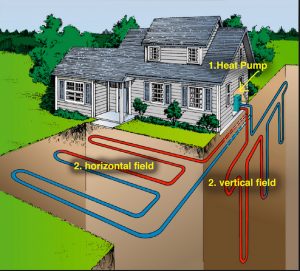
The geothermal pump industry is relishing a resurgence as a result of extreme weather conditions and rising utility costs. A major push is now underway to get people to consider ground source heat pumps because they use far less electricity than other heating and cooling methods, according to a recent article by the Associated Press.
“Ground source heat pumps average about 30 percent less electricity use than air-source heat pumps over the course of the heating season,” said Michael Waite, senior manager in the buildings program at the American Council for an Energy Efficient Economy.
To install ground source systems, contractors use heavy equipment to drill and bury a loop of flexible piping several hundred feet deep into the ground. Water flowing through the loop takes advantage of the underground temperature – a fairly stable 55 degrees.
Often indoors or within the basement, a unit contains refrigerant — a fluid that can easily absorb a lot of heat. During the summer, the water in the loop dumps heat into the ground. In the winter, it pulls heat from the earth with amazing efficiency and moves it indoors.
“We really feel like we’re on the right side of a megatrend,” said Tim Litton, director of marketing communications for WaterFurnace, a geothermal manufacturer in Fort Wayne, Indiana.
With the better known air source heat pumps, outdoor parts can ice over in winter, with the system pulling heat from indoors to thaw out. There are additional issues with animals, debris and dirt.
WaterFurnace systems can be installed in yards as small as 15 by 15 feet but the drilling rigs cannot get in the limited spaces where homes are really close together, according to Litton.
There is “a lot of demand for geothermal right now,” said Mark Schultz, president of Earth River Geothermal in Maryland. The interest in reducing carbon emissions is also a big motivator for customers. “They have electric vehicles in the driveway and solar panels on the roof,” he said.
In the Midwest, Litton sees a broad range of buyers. “We kind of span the entire political spectrum — whether you’re a progressive environmentalist or a fiscal conservative,” he said. “It’s kind of nice in these divisive times to have something to agree on,” he said.
The sticker prices for ground source are higher than traditional systems but tax credits may make a difference in the market. The Inflation Reduction Act of 2022 highly incentivizes geothermal pumps with a 30% tax credit. If a customer purchased a $30,000 system, he would end up paying $21,000. If someone doesn’t owe enough taxes in one year to benefit from that, it can be carried over to the next year. There is no dollar limit on the credit, unlike air source units, which are capped at $2,000.
Some states also offer incentives on top of the federal tax credit. In South Carolina, residents get another 25% credit. That means a homeowner could end up with a 55% discount off the initial cost. Some utilities offer incentives too.
People who live in places with cold winters and hot summers reap the biggest savings although leaders at three companies cite initial cost as a barrier.
In April of this year, the U.S. Department of Energy announced 11 communities across 10 states were selected to design community geothermal heating and cooling systems as part of President Biden’s Justice40 initiative. One of the rural communities includes Shawnee, Oklahoma under a partnership led by the University of Oklahoma involving a combined solar and geothermal heat pump heating and cooling system to be demonstrated in a community owned and operated by a tribal nation.
Community-scale geothermal systems are relatively common outside the United States but have a comparably small presence domestically. These selections represented the first of two phases in a $13 million initiative to support the design and eventual deployment of community geothermal heating and cooling systems.






